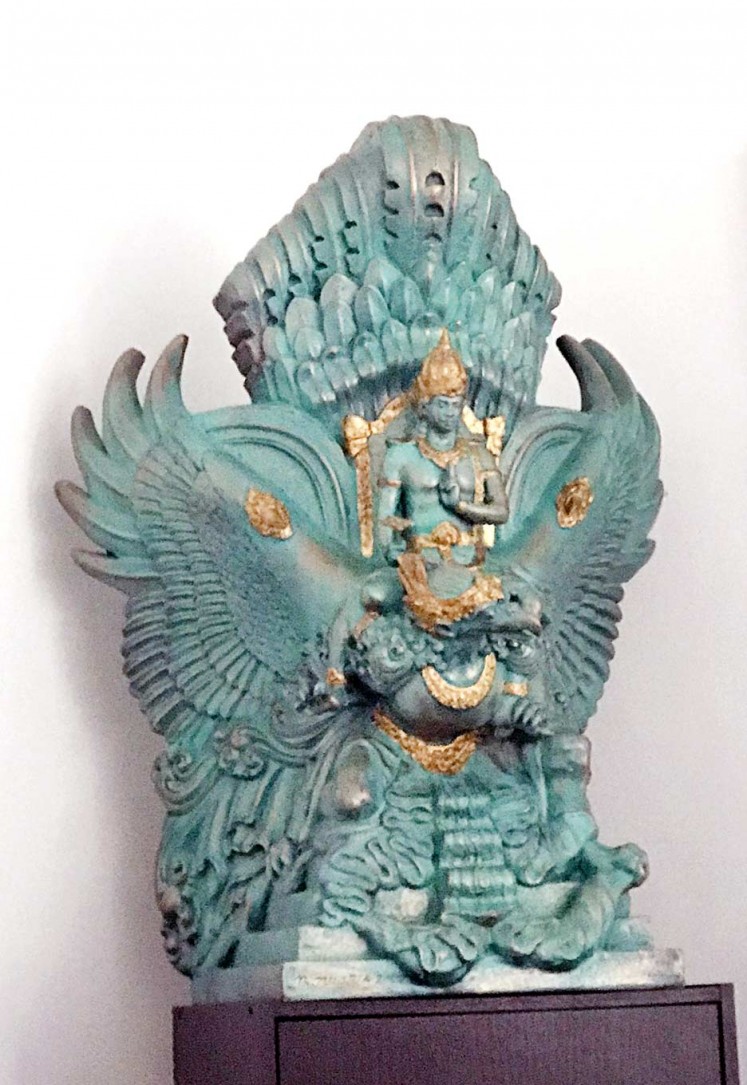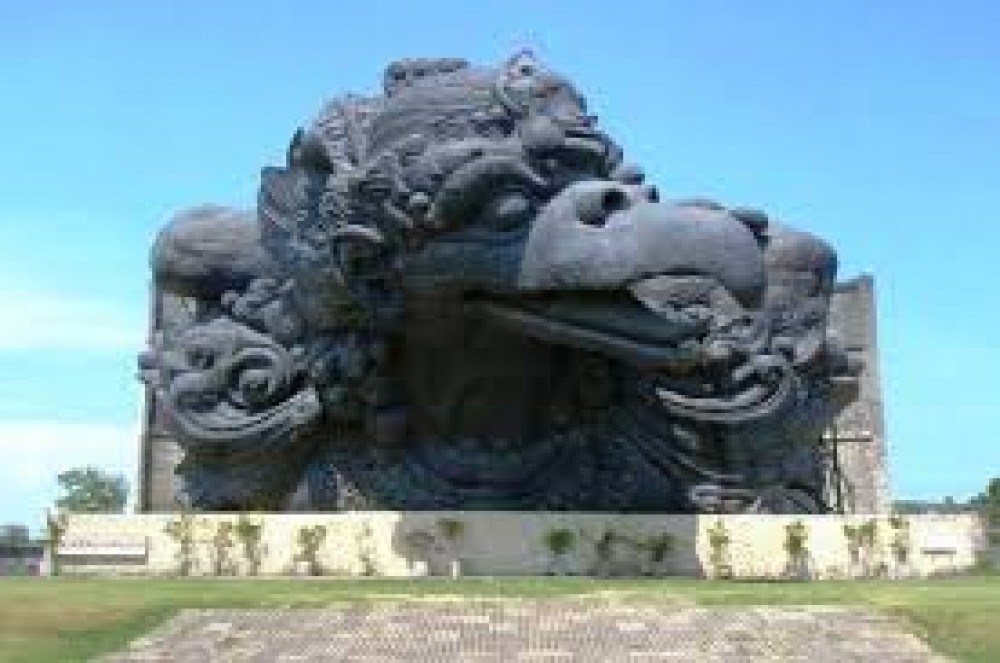Indonesia’s tallest statue will be a gift to celebrate the nation’s Independence Day in 2018.
Despite cloudy skies and brief downpours, the afternoon was hot and humid. Not exactly the perfect conditions to scale the steps leading to the as yet unfinished platform that is marked by rows of bare concrete pillars.
The platform is spacious and could easily accommodate more than 100 cars. It is open on all sides, giving a 360-degree bird’s eye view of the scenery below.
The sprawling 60-hectare Garuda Wisnu Kencana cultural park with its gigantic limestone columns, the host of numerous world-class concerts, sits below and Benoa Bay, now the most contentious site in Bali because of a controversial reclamation plan, lies in the distance, both clearly visible from the platform’s eastern side
A worker cleans the wet floor while groups of wielders are busy working on steel frames and tubes that intersect each other before jutting out into the gloomy sky.
A brightly painted red crane to the platform’s western side is the only thing that adds color to the otherwise steely gray scene.
“We are now 93.5 meters above the ground,” famed sculptor Nyoman Nuarta said as he pointed to a gigantic head of Garuda.
“We have just finished installing the torso and the head of the Garuda, one of the most critical stages of the construction process,”
His comments referred to Garuda Wisnu Kencana, a gigantic monument he first conceptualized back in 1993.
“It was very challenging technically because the bust of the 22-m tall Garuda protrudes 30-m outward from the statue’s inner core.
“As you can imagine, we had to construct a 30-m long cantilever before installing the torso,” he said.
The next technically challenging task is to install the wings of the mythical bird. Because of Nuarta’s insistence on endowing the wings with the illusion of movement, requiring additional reinforcements of the frame, the space available inside the wings’ tips for fine-tuning the installation can only accommodate one worker.


Myth: A scale model of the Garuda Wisnu Kencana monument. When completed, it will be taller than the Statue of Liberty. (Siluet Nyoman Nuarta/File)
Designed to be the country’s tallest statue, Garuda Wisnu Kencana was inspired by Hindu mythology about the search for Amerta (the elixir of life). According to this myth, Garuda agreed to be ridden by Lord Wisnu in return for the right to use the elixir to liberate his enslaved mother.
The 75-m tall, 65-m wide statue, sits atop a lofty pedestal that will bring the total height of the monument to 121-m, nearly 30-m taller than the Statue of Liberty in the United States. The completed monument will be about as tall as a 21-story building. It will weigh 4,000 tons, thus, making it the heaviest statue in the country.
The statue is made of copper and brass sheeting, with a stainless steel frame and skeleton, as well as a steel and concrete core column. The outer covering alone measures 22,000 square m in size. It was constructed in Nuarta’s workshop in Sarijadi, Bandung, West Java, before being chopped into more than 700 modules and transported to the construction site in Ungasan, Badung regency.
As many as 120 experienced wielders are currently working at the site to re-assemble the modules before they are lifted up by two cranes and bolted onto the outer steel frame of the statue by workers who specialize in high altitude construction.
“By next week we will have completed the installation of the 300th module. The head of Wisnu will be put into place by April next year,”
Around 24 years after its inception, there is finally light at the end of what has been a very dark tunnel for the construction of the Garuda Wisnu Kencana monument. It has survived many gigantic setbacks, ranging from early opposition from a group of local activists to internal disputes within the company responsible for its development, to political regime change and global financial crisis. The latter forced the project into a 16-year long hiatus before the giant property developer PT Alam Sutera Realty Tbk. took over in 2013 and injected fresh funds.
For Nyoman Nuarta, the construction of the monument has become a life-long obsession.
“The difficulty level is incomparable to the other projects because Garuda Wisnu Kencana is colossal in size and also very elaborately decorated,” he said, gesturing toward the richly ornamented crown of Garuda.
“Wisnu’s crown will be covered with golden mosaics and the whole statue will have a special lighting arrangement, which is currently being built in Singapore,” he said.
Nuarta is also fanatical about the safety of the monument, with the construction materials, steel frames and the statue itself having undergone various scientific integrity tests. This included a wind tunnel test that revealed the statue could withstand winds with speeds of up to 259 nautical miles per hour. In Bali, the highest recorded winds travel at 70 nautical miles per hour.
“I want it to last 100 years,”
The statue is slated to be completed by August 2018 and Nuarta plans to throw a public party to celebrate the inauguration of the monument.
“It will be my gift to the country that I love so much. A cultural gift to celebrate the 73rd anniversary of our independence,”
2018 will also be a busy year politically, with regional elections to be held across the country.
“Hopefully, Garuda Wisnu Kencana will serve as a reminder throughout that divisive period about our cultural roots as a tolerant and multicultural nation,” he said.